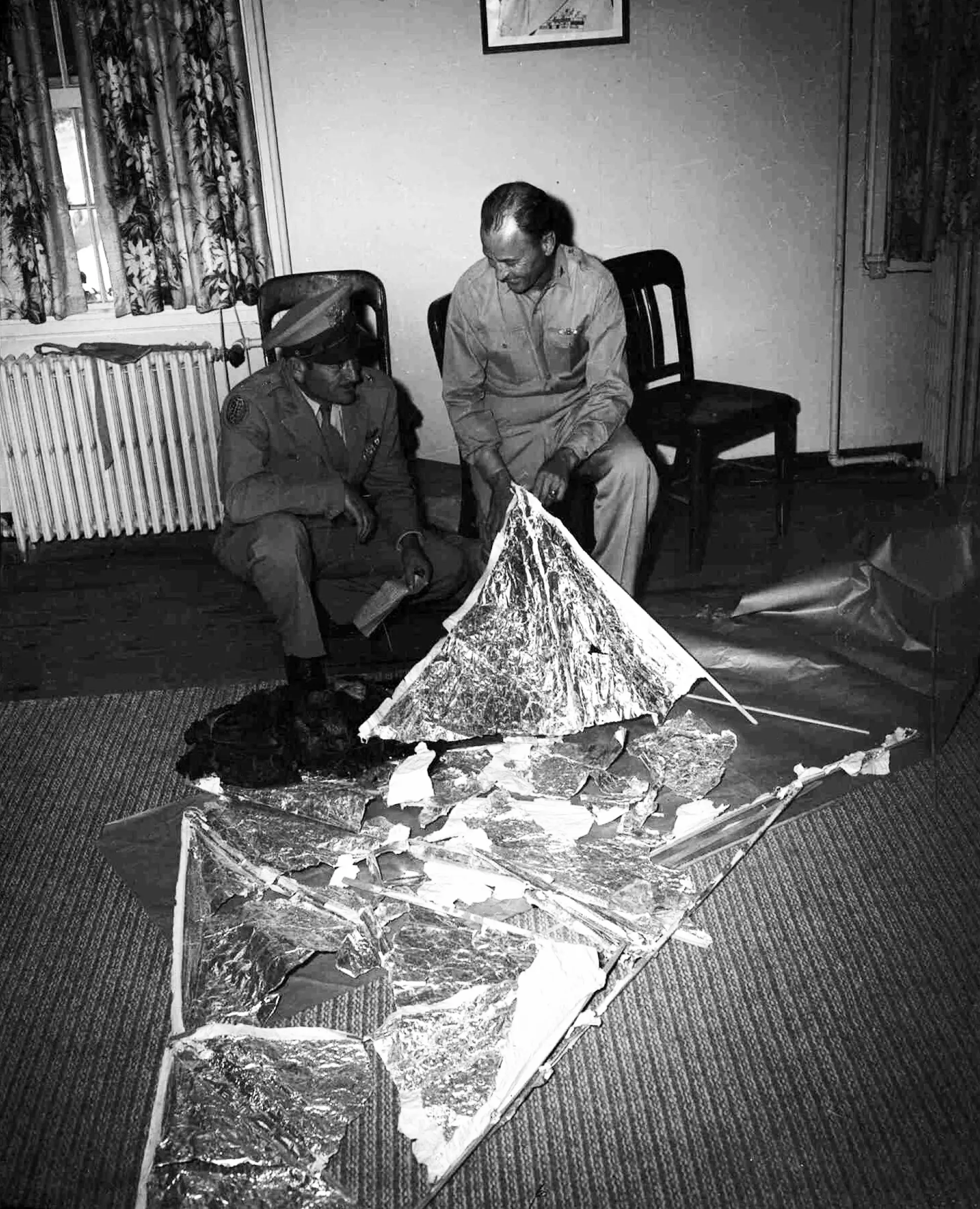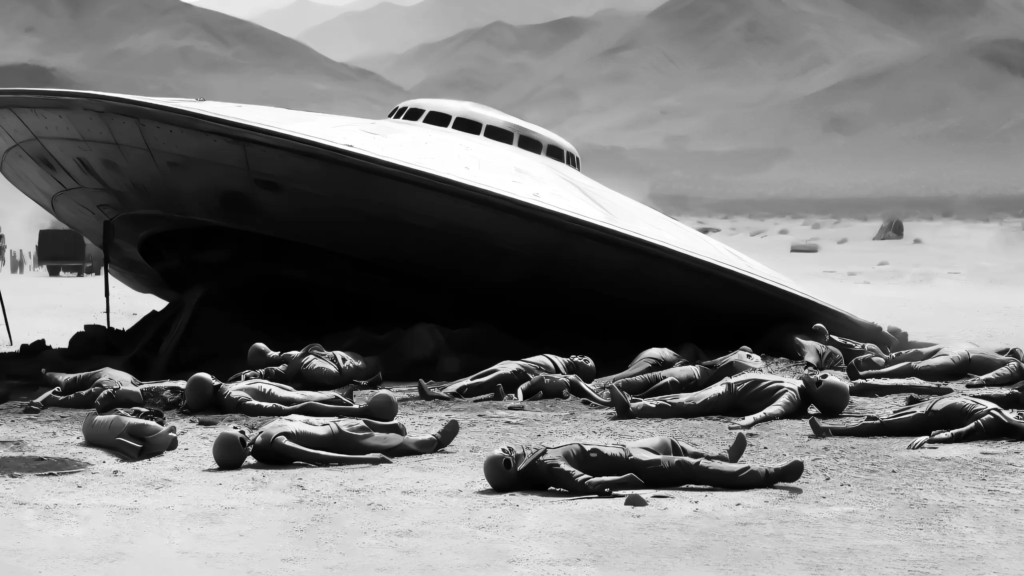Introduction
The Roswell Incident, a watershed moment in the annals of UFO history, continues to captivate the imaginations of enthusiasts, sceptics, and scholars alike. The events that unfolded in the summer of 1947 in Roswell, New Mexico, have become synonymous with the elusive nature of extra-terrestrial encounters and government secrecy. This essay aims to delve into the history of the Roswell Incident, exploring its various facets, eyewitness accounts, and the myriad of explanations proposed over the years.
Historical Context
In the post-World War II era, the United States experienced a surge in UFO sightings, prompting widespread interest in unidentified flying objects and the possibility of extra-terrestrial life. The Cold War heightened tensions between the United States and the Soviet Union, intensifying the scrutiny of the skies for potential threats. Against this backdrop, the Roswell Incident unfolded in early July 1947.
On July 8, 1947, a press release issued by the Roswell Army Air Field (RAAF) public information officer, Walter Haut, announced the recovery of a “flying disc” on a ranch near Roswell. The news quickly spread, with headlines proclaiming the military’s capture of a UFO. However, the fervour was short-lived, as the following day, the military changed its narrative, stating that the recovered object was a weather balloon, specifically a Rawin target device used for atmospheric research.
Eyewitness Accounts
The controversy surrounding the Roswell Incident gained momentum due to conflicting eyewitness accounts, adding layers of mystery to the already enigmatic event. Numerous individuals claimed to have witnessed unusual debris scattered across the Foster Ranch, where the purported crash occurred. Eyewitnesses described metallic fragments, strange symbols, and a distinct lack of resemblance to conventional weather balloons.
One of the key witnesses, rancher William “Mac” Brazel, discovered the debris on his property and reported it to the local sheriff. Brazel described the wreckage as unusual, prompting the military’s involvement. Additionally, other witnesses, including Brazel’s son and neighbours, attested to the peculiar nature of the debris, contradicting the official explanation of a weather balloon.
The testimony of Major Jesse Marcel, the intelligence officer who initially inspected the wreckage, added fuel to the conspiracy theories surrounding the Roswell Incident. Marcel claimed that the debris he examined was not consistent with any conventional aircraft or weather balloon. According to him, the material was lightweight, yet incredibly strong, and featured strange symbols resembling hieroglyphics.
Government Secrecy and Cover-Up Allegations
The abrupt reversal in the military’s initial statements, coupled with conflicting eyewitness accounts, fuelled suspicions of a government cover-up. Conspiracy theorists argue that the U.S. government retrieved an extra-terrestrial spacecraft and its occupants, initiating a clandestine operation to conceal the truth from the public. The notion of a massive cover-up gained traction over the years, with proponents pointing to the secrecy surrounding the incident as evidence of a hidden agenda.
Critics argue that the weather balloon explanation was a convenient cover story, designed to divert attention from a more sensational truth. The Roswell Incident became a focal point for those sceptical of official government narratives, leading to a persistent belief that the truth about extra-terrestrial contact was being concealed for national security reasons.
Possible Explanations
While the extra-terrestrial hypothesis remains a tantalizing possibility for some, various alternative explanations have been proposed to debunk the notion of a UFO crash near Roswell. Sceptics and researchers alike have offered alternative perspectives on the nature of the debris and the events surrounding the incident.
1. Project Mogul
One of the primary alternative explanations put forth by sceptics involves Project Mogul, a top-secret U.S. government project aimed at monitoring Soviet nuclear testing. The project utilized high-altitude balloons equipped with sensitive acoustic equipment to detect sound waves from distant explosions. Proponents of the Project Mogul theory argue that the debris found near Roswell was likely remnants of these experimental balloons and associated equipment.
2. High-Altitude Balloon Crash
Another explanation suggests that the debris discovered at the Foster Ranch was indeed from a high-altitude balloon, but not necessarily part of Project Mogul. Some researchers propose that the military may have been testing other experimental balloons or devices, and a crash occurred, leading to the confusion and secrecy surrounding the incident.
3. Cold War Hysteria
The context of the Cold War and the heightened fear of Soviet espionage also played a role in shaping public perception during this period. Some argue that the military’s quick retraction of the initial “flying disc” statement was a result of the prevailing atmosphere of paranoia and a desire to avoid causing undue panic among the public.
4. Psychological Warfare
A more speculative theory posits that the Roswell Incident was part of a psychological warfare experiment. According to this view, the military intentionally disseminated conflicting information to gauge public and international reactions to the idea of a UFO crash. The objective would have been to assess the impact of such an event on societal stability and foreign relations.
Conclusion
The Roswell Incident stands as a complex and enduring enigma in the history of UFO phenomena. The events of July 1947 in Roswell, New Mexico, have given rise to numerous theories, ranging from extra-terrestrial encounters to government cover-ups and experimental military projects. The conflicting eyewitness accounts, the abrupt changes in official statements, and the lingering secrecy surrounding the incident have fuelled decades of speculation and intrigue.
While the extra-terrestrial hypothesis remains a captivating narrative for many, alternative explanations such as Project Mogul, high-altitude balloon crashes, Cold War hysteria, and psychological warfare experiments provide plausible alternatives. The Roswell Incident serves as a symbol of humanity’s enduring fascination with the unknown, prompting ongoing investigations, debates, and speculation about the mysteries that may lie beyond our earthly boundaries. As technology advances and new information emerges, the quest for answers regarding the Roswell Incident continues, ensuring that this chapter in UFO history will remain a subject of fascination and debate for years to come.

Geolocation: 33.400322, -104.534897
Further Reading: Coming Soon
Photo Credits: Angelo Scarcella
Introduction
The Roswell Incident, a watershed moment in the annals of UFO history, continues to captivate the imaginations of enthusiasts, sceptics, and scholars alike. The events that unfolded in the summer of 1947 in Roswell, New Mexico, have become synonymous with the elusive nature of extra-terrestrial encounters and government secrecy. This essay aims to delve into the history of the Roswell Incident, exploring its various facets, eyewitness accounts, and the myriad of explanations proposed over the years.
Historical Context
In the post-World War II era, the United States experienced a surge in UFO sightings, prompting widespread interest in unidentified flying objects and the possibility of extra-terrestrial life. The Cold War heightened tensions between the United States and the Soviet Union, intensifying the scrutiny of the skies for potential threats. Against this backdrop, the Roswell Incident unfolded in early July 1947.
On July 8, 1947, a press release issued by the Roswell Army Air Field (RAAF) public information officer, Walter Haut, announced the recovery of a “flying disc” on a ranch near Roswell. The news quickly spread, with headlines proclaiming the military’s capture of a UFO. However, the fervour was short-lived, as the following day, the military changed its narrative, stating that the recovered object was a weather balloon, specifically a Rawin target device used for atmospheric research.
Eyewitness Accounts
The controversy surrounding the Roswell Incident gained momentum due to conflicting eyewitness accounts, adding layers of mystery to the already enigmatic event. Numerous individuals claimed to have witnessed unusual debris scattered across the Foster Ranch, where the purported crash occurred. Eyewitnesses described metallic fragments, strange symbols, and a distinct lack of resemblance to conventional weather balloons.
One of the key witnesses, rancher William “Mac” Brazel, discovered the debris on his property and reported it to the local sheriff. Brazel described the wreckage as unusual, prompting the military’s involvement. Additionally, other witnesses, including Brazel’s son and neighbours, attested to the peculiar nature of the debris, contradicting the official explanation of a weather balloon.
The testimony of Major Jesse Marcel, the intelligence officer who initially inspected the wreckage, added fuel to the conspiracy theories surrounding the Roswell Incident. Marcel claimed that the debris he examined was not consistent with any conventional aircraft or weather balloon. According to him, the material was lightweight, yet incredibly strong, and featured strange symbols resembling hieroglyphics.

Government Secrecy and Cover-Up Allegations
The abrupt reversal in the military’s initial statements, coupled with conflicting eyewitness accounts, fuelled suspicions of a government cover-up. Conspiracy theorists argue that the U.S. government retrieved an extra-terrestrial spacecraft and its occupants, initiating a clandestine operation to conceal the truth from the public. The notion of a massive cover-up gained traction over the years, with proponents pointing to the secrecy surrounding the incident as evidence of a hidden agenda.
Critics argue that the weather balloon explanation was a convenient cover story, designed to divert attention from a more sensational truth. The Roswell Incident became a focal point for those sceptical of official government narratives, leading to a persistent belief that the truth about extra-terrestrial contact was being concealed for national security reasons.
Possible Explanations
While the extra-terrestrial hypothesis remains a tantalizing possibility for some, various alternative explanations have been proposed to debunk the notion of a UFO crash near Roswell. Sceptics and researchers alike have offered alternative perspectives on the nature of the debris and the events surrounding the incident.
1. Project Mogul
One of the primary alternative explanations put forth by sceptics involves Project Mogul, a top-secret U.S. government project aimed at monitoring Soviet nuclear testing. The project utilized high-altitude balloons equipped with sensitive acoustic equipment to detect sound waves from distant explosions. Proponents of the Project Mogul theory argue that the debris found near Roswell was likely remnants of these experimental balloons and associated equipment.
2. High-Altitude Balloon Crash
Another explanation suggests that the debris discovered at the Foster Ranch was indeed from a high-altitude balloon, but not necessarily part of Project Mogul. Some researchers propose that the military may have been testing other experimental balloons or devices, and a crash occurred, leading to the confusion and secrecy surrounding the incident.
3. Cold War Hysteria
The context of the Cold War and the heightened fear of Soviet espionage also played a role in shaping public perception during this period. Some argue that the military’s quick retraction of the initial “flying disc” statement was a result of the prevailing atmosphere of paranoia and a desire to avoid causing undue panic among the public.
4. Psychological Warfare
A more speculative theory posits that the Roswell Incident was part of a psychological warfare experiment. According to this view, the military intentionally disseminated conflicting information to gauge public and international reactions to the idea of a UFO crash. The objective would have been to assess the impact of such an event on societal stability and foreign relations.
Conclusion
The Roswell Incident stands as a complex and enduring enigma in the history of UFO phenomena. The events of July 1947 in Roswell, New Mexico, have given rise to numerous theories, ranging from extra-terrestrial encounters to government cover-ups and experimental military projects. The conflicting eyewitness accounts, the abrupt changes in official statements, and the lingering secrecy surrounding the incident have fuelled decades of speculation and intrigue.
While the extra-terrestrial hypothesis remains a captivating narrative for many, alternative explanations such as Project Mogul, high-altitude balloon crashes, Cold War hysteria, and psychological warfare experiments provide plausible alternatives. The Roswell Incident serves as a symbol of humanity’s enduring fascination with the unknown, prompting ongoing investigations, debates, and speculation about the mysteries that may lie beyond our earthly boundaries. As technology advances and new information emerges, the quest for answers regarding the Roswell Incident continues, ensuring that this chapter in UFO history will remain a subject of fascination and debate for years to come.

Geolocation: 33.400322, -104.534897
Further Reading: Coming Soon
Photo Credits: Angelo Scarcella
